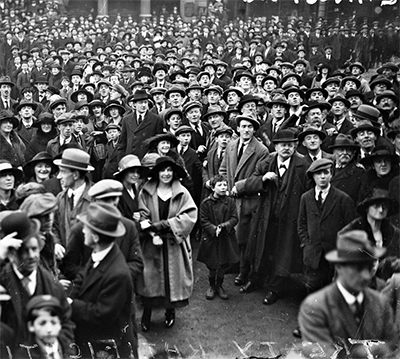TREATY DEBATES IN THE DÁIL
Published in Issue 1 (January/February 2022), Volume 30By Joseph E.A. Connell Jr

Above: Crowds gather outside Dublin’s Earlsfort Terrace to await news of the vote on the Treaty, January 1922. (NLI)
The Treaty debates began in the Mansion House on Dawson Street on 19 December 1921. The Dáil assembled and Eamon de Valera’s ‘Document No. Two’ was derided by Arthur Griffith and Seán Milroy. Griffith moved the ratification of the Treaty and Seán MacEoin seconded it.
The next day the debate continued; de Valera remarked that ‘Something else besides the Treaty came from Downing Street’. On 21 December 1921 the Dáil adjourned on the motion of Michael Collins to reassemble on 3 January 1922. The debates resumed on that date and continued for five days in the Convocation Hall of the National University of Ireland on Earlsford Terrace.
On 4 January 1922 de Valera ‘resigned’, but it was unclear whether he resigned as president or prime minister or both. Though there was disagreement over the lack of a named ‘Republic’, dominion status versus ‘external association’ and Ulster partition, the primary disagreement was over the oath required in the Treaty:
‘I […] do solemnly swear true faith and allegiance to the Constitution of the Irish Free State as by law established and that I will be faithful to HM George V, his heirs and successors by law, in virtue of the common citizenship of Ireland and Great Britain and her adherence to and membership of the group of nations forming the British Commonwealth of Nations.’
De Valera proposed an oath on the following lines:
‘I […] swear to obey the Constitution of Ireland and to keep faith with his Britannic Majesty, HM George V, in respect of the treaty associating Ireland with the states of the British Commonwealth.’
Robert Kee wrote:
‘The chief mistake the Irish delegation made was to allow the two all-important issues of the Crown and Ulster to become confused. They did not sufficiently single out Ulster as the issue on which to challenge the British. This was largely because, though the unity of Ireland was more important than the issue of allegiance to most Irish citizens, the issue of allegiance was of equal importance to the minority of Republican dogmatists whom the delegates also represented.’
On 7 January 1922 the Dáil voted 64‒57 to ratify the Treaty. A total of 122 TDs answered the roll for the day, but Eoin MacNeill (who would have voted in favour), as chairman, did not vote. Frank Drohan resigned, as he was unwilling to vote for the Treaty but did not want to flout the will of his constituents and vote against it. Tom Kelly (who would have voted in favour) was too ill to attend. Laurence Ginnell (who would have voted against) did not attend, as he was in Argentina. All six women TDs voted against the Treaty.
It was an afternoon meeting, beginning at 4pm, and voting started at 8.35pm with Diarmuid O’Hegarty calling the roll, continuing until 9pm. Five TDs represented more than one constituency (Collins, de Valera, Griffith, Liam Mellows and Milroy) but all such TDs cast only one ballot, even though Griffith objected strenuously to such multiple constituencies being ‘disenfranchised’.
On 9 January de Valera resigned and put himself forward for re-election as president the following day; he was defeated by Arthur Griffith, 60 votes to 58. De Valera’s expressed view was that ‘The Republic must exist until the people disestablish it’. He also said: ‘I hope that nobody will talk of fratricidal strife. That is all nonsense. We have a nation that knows how to conduct itself.’
Joseph E.A. Connell is the author of The Terror War: the uncomfortable realities of the Irish War of Independence (Eastwood Books).
















